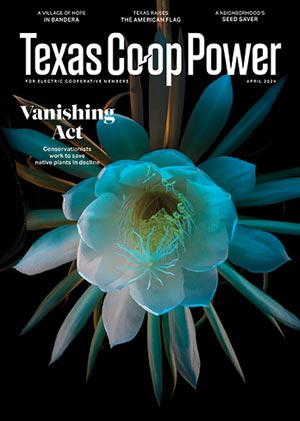From the road, it doesn’t stand out from any other small office complex you might find in the Hill Country. But once you pass through the towering iron gate, get out of your car and start walking, the landscape becomes much more inviting: winding paths that lead to a peaceful courtyard and a sprawling pergola nestled against a scenic lily pond.
This is what hope looks like. More specifically, the Village of Hope—the cluster of buildings owned by Bandera County Helping Hand, a haven for residents facing a personal crisis. Are you sick? There’s a free medical clinic. Is your cupboard bare? Head over to the food pantry. Do you need shoes, clothes or basic household items? The thrift store has what you need.
Since 1984, Bandera Helping Hand has been a steadfast safety net for folks who have hit hard times.
“We’re here to help people get on their feet,” says Jesse Parks, executive director of Helping Hand. “You never know what tomorrow will bring. Everything’s great until all of a sudden there’s a car wreck and somebody’s gone or there’s a flood or a fire and you’ve lost everything. It’s devastating.”
Parks speaks from experience. In the late 1990s, she and her husband uprooted their lives in Corpus Christi and moved to Medina, just west of Bandera, where they signed a long-term lease on a piece of land and started working on their dream: building a facility for teens experiencing crisis. Two years later, without warning, the landowner sold it out from under them, including the structures and improvements they’d funded with their own money.
They lost everything. To make ends meet, Parks got a job at the Apple Store in Medina (which actually sells fruit). One day a friend came in and told her that she’d recommended Parks for the director position at Helping Hand. Even though she’d never worked at a nonprofit, Parks accepted the position and has led the organization since 2000.

Angelica Hernandez greets patients at the medical clinic, which is open three days a week.
Laura Jenkins

The food pantry can feed 130 families a month.
Laura Jenkins
Helping Hand began 16 years earlier, in 1984, when local churches came together to assist neighbors in need. The aim was to pool resources and provide a central place where people could go for help. In the early days, Helping Hand operated a thrift store and a food pantry and provided school supplies for children. It also helped struggling residents pay their utility bills.
But when the Medina River swept through the town during the devastating South Texas floods of 2002, it demolished Helping Hand’s facilities. Quite suddenly they were among those in crisis.
“Our building was completely destroyed,” Parks remembers, “so we set up shop in a warehouse and started gathering donations from other food banks. The Salvation Army came in and helped us provide aid for flood victims as well.”
Seeing how generously and efficiently Helping Hand had been serving the community, Bandera’s city council offered them space so they could continue helping residents while they figured out how to start over themselves. And that’s when offers of help started pouring in.
“A retired grant writer by the name of Dan Wise got in touch and offered to help us raise funds to rebuild,” says Parks, a member of Bandera Electric Cooperative. “I looked forever for land that was not in a flood plain and finally found this 3.77 acres. We bought it with money we borrowed from Bandera Bank but were able to pay it back within a year using the grants that Mr. Wise helped us get from various foundations.”
By early 2004, Helping Hand’s crisis intervention center was complete. At the building’s dedication, then-board President Comellia Rue announced that the next structure they would build was a free medical clinic to serve the county’s uninsured residents. But no one had any idea where the money would come from.
Enter Kerrville businessman Arthur Nagel, who approached the pastor of a local church and told him God had given him a vision to start a medical clinic in Bandera. The pastor introduced Parks to Nagel, who donated $150,000 to construct the shell of the clinic building on the Village of Hope grounds. Within a year, Helping Hand had raised enough money to complete the clinic and operate it for a year. The clinic formed its own nonprofit and opened its door to patients in 2008.
Today the Arthur Nagel Community Clinic is open three days a week. In addition to primary care, the clinic offers mental health services and teen and elder care programs. Healthy cooking and cardio fitness classes are also available. The clinic provided an estimated $1.9 million in health services to 443 Bandera County residents in 2023, says clinic director Chuck Lutke.
The food pantry stays stocked thanks to food and cash donations from individuals and contributions from other food banks. As a result, Helping Hand can feed an average of 130 families a month.
At the thrift store, which thrives on steady donations of gently used clothing and household items, residents purchase what they need at affordable prices. Sales cover nearly three-fourths of Helping Hand’s annual operating budget.
“Helping Hand is about community,” Parks says. “We all work as a team. I see us as a community of ‘hands’ that resources pass through. Each one of us has been through hard times and knows what a little compassion and love can mean in a crisis situation.
“Helping people get back on their feet and feeling good about themselves as they overcome whatever they’re going through is a privilege.
“It’s not a handout, it’s a hand up.”



